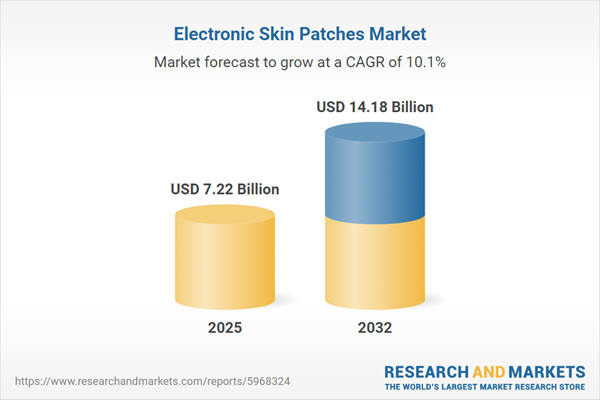Speak directly to the analyst to clarify any post sales queries you may have.
The electronic skin patches market is reshaping healthcare delivery by enabling continuous, non-invasive monitoring and targeted therapy through advanced wearable technologies. Senior leaders in MedTech, pharmaceuticals, and healthcare systems are leveraging these solutions to optimize patient outcomes and operational efficiency within a competitive innovation landscape.
Market Snapshot: Electronic Skin Patches Market Growth & Dynamics
The electronic skin patches market grew from USD 6.55 billion in 2024 to USD 7.22 billion in 2025. It is projected to expand further at a compound annual growth rate (CAGR) of 10.13%, reaching USD 14.18 billion by 2032. Demand is driven by the convergence of advanced biomaterials, miniaturized electronics, and healthcare digitization, enabling integration of real-time monitoring and therapy within daily routines. Growth is strengthened by strategic investments in manufacturing innovation, favorable regulatory updates, and tailored adoption strategies across major global regions.
Scope & Segmentation: Strategic Overview
- Application: Diagnostic biomarker detection, disease screening, drug delivery for chemotherapy, insulin, or pain management, fitness and wellness tracking, continuous health monitoring, and wound management for acute and chronic lesions.
- Product Type: Hybrid patches combining sensing and delivery, sensor patches using electrochemical, optical, piezoelectric, or thermal modalities, and therapeutic patches for drug release or electrical stimulation.
- Technology: Flexible electronics, printed electronics with inkjet or screen printing, and stretchable electronics for enhanced comfort and function.
- End User: Diagnostic centers, hospitals, home care settings, and research institutes with varying performance and support requirements.
- Distribution Channel: Direct sales, hospital and retail pharmacies, and online channels facilitate adaptable go-to-market approaches.
- Regions: Coverage includes North America (United States, Canada, Mexico), Latin America (Brazil, Argentina, Chile, Colombia, Peru), Europe (United Kingdom, Germany, France, Russia, Italy, Spain, Netherlands, Sweden, Poland, Switzerland), Middle East (UAE, Saudi Arabia, Qatar, Turkey, Israel), Africa (South Africa, Nigeria, Egypt, Kenya), and Asia-Pacific (China, India, Japan, Australia, South Korea, Indonesia, Thailand, Malaysia, Singapore, Taiwan).
- Companies Covered: Abbott Laboratories, DexCom, Inc., Medtronic plc, Insulet Corporation, iRhythm Technologies, Inc., Boston Scientific Corporation, Koninklijke Philips N.V., Senseonics Holdings, Inc., Nemaura Medical Plc, Omron Corporation.
Key Takeaways: Insights for Senior Decision-Makers
- Material breakthroughs, including nanostructured hydrogels and conductive polymers, are raising device sensitivity and extending product lifespans in electronic skin patch development.
- Flexible and stretchable substrates now enhance patient comfort and long-term adherence, increasing clinical acceptance across diverse care settings.
- Regulatory harmonization, particularly in the US and EMEA, supports faster commercialization and investment by standardizing requirements for next-generation devices.
- Collaborations—between medical device OEMs, technology firms, and research institutions—are driving innovation in both biosensor technologies and integrated data ecosystems for healthcare analytics.
- Distribution strategies increasingly include digital and online channels, supporting broader market reach and facilitating patient access to advanced monitoring solutions.
Tariff Impact: Navigating Cost and Supply Chain Shifts
Recent US tariff policies impacting specialized polymers and conductive inks have triggered a reassessment of global sourcing strategies for electronic skin patch manufacturing. Companies are investing in domestic supply networks and production lines to reduce duty exposure, driving near-term costs but ultimately aiming for enhanced supply resilience and cost predictability. Strategic shifts are also prompting innovation in alternative local materials and closer collaboration among R&D and manufacturing partners across key regions.
Methodology & Data Sources
This market research employs comprehensive secondary analysis, drawing on peer-reviewed publications, regulatory filings, and financial records. Primary insights are collected via structured interviews with industry executives, R&D leads, and clinical end users. Quantitative modeling and expert validation ensure findings align with current trends and market drivers, delivering high-integrity results for strategic planning.
Why This Report Matters: Actionable Intelligence for Strategic Growth
- Enables leadership teams to anticipate technology and regulatory shifts and inform product development or regional expansion priorities.
- Clarifies competitive dynamics and partnership opportunities, supporting investment or acquisition strategies in a fast-evolving medtech sector.
- Delivers market-tested recommendations for building resilience and capturing value across the electronic skin patches value chain.
Conclusion
The electronic skin patches market presents expanding opportunities as it fuels the evolution of personalized healthcare and remote monitoring. Approaching this landscape with strategic foresight supports innovation, differentiation, and sustainable growth.
Additional Product Information:
- Purchase of this report includes 1 year online access with quarterly updates.
- This report can be updated on request. Please contact our Customer Experience team using the Ask a Question widget on our website.
Table of Contents
3. Executive Summary
4. Market Overview
7. Cumulative Impact of Artificial Intelligence 2025
Companies Mentioned
The companies profiled in this Electronic Skin Patches market report include:- Abbott Laboratories
- DexCom, Inc.
- Medtronic plc
- Insulet Corporation
- iRhythm Technologies, Inc.
- Boston Scientific Corporation
- Koninklijke Philips N.V.
- Senseonics Holdings, Inc.
- Nemaura Medical Plc
- Omron Corporation
Table Information
| Report Attribute | Details |
|---|---|
| No. of Pages | 198 |
| Published | November 2025 |
| Forecast Period | 2025 - 2032 |
| Estimated Market Value ( USD | $ 7.22 Billion |
| Forecasted Market Value ( USD | $ 14.18 Billion |
| Compound Annual Growth Rate | 10.1% |
| Regions Covered | Global |
| No. of Companies Mentioned | 11 |









